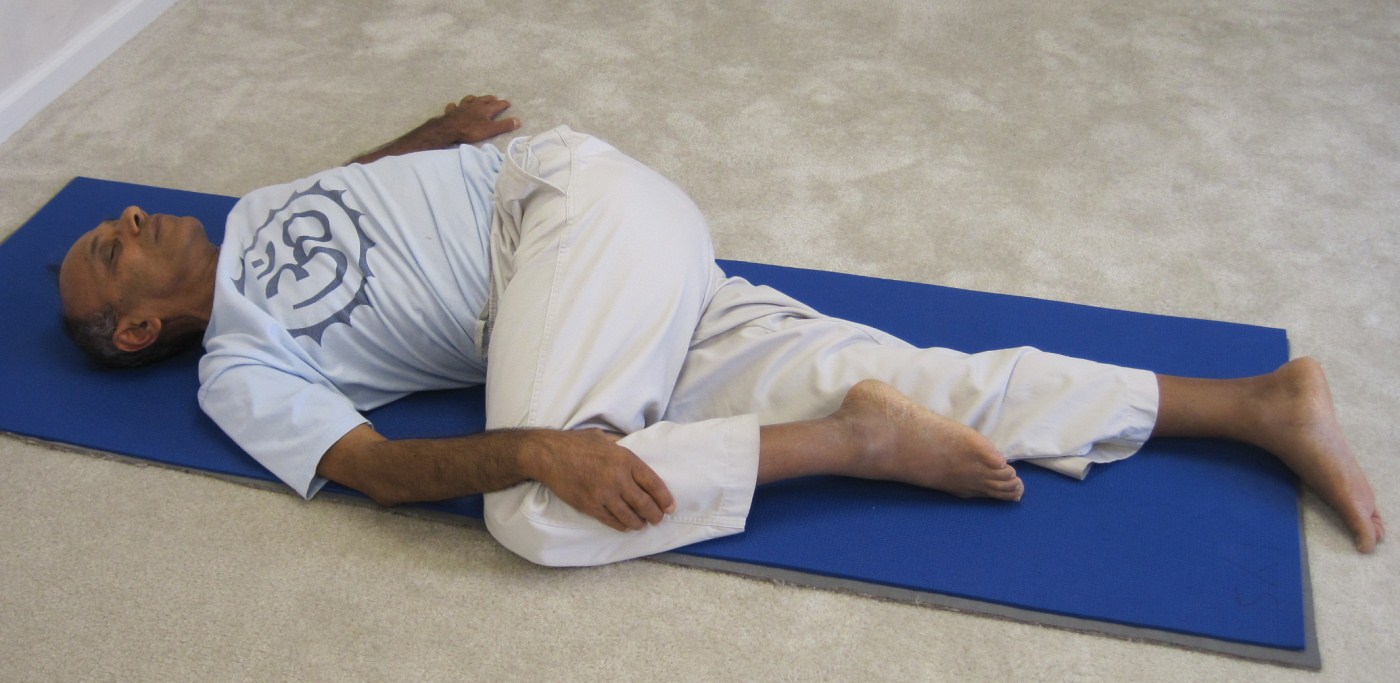Lower back pain is perhaps the single most commonly mentioned reasons why people join yoga classes. There are several yoga poses that are recommended for taking care of lower back pain – for example, Marjarasana (cat & cow), Pawanamuktasana (wind-relieving pose), Balasana (child pose), all twisting poses etc. One of the poses that I personally enjoy and recommend highly is the Reclining Twist. In Sanskrit, it is variously named as Jathara Parivartanasana – जठरपरिवर्तनासन – (Abdomen Turning), Udarakarshanasana – उदराकर्षणासन – (abdominal stretching), and Supta Matsyendrasana – सुप्तमत्स्येन्द्रासन – (Reclining twist).
The reclining twist is what I call a "feel good asana" as it stretches multiple parts of the body in a gentle way and brings about a sense of refreshing rejuvenation and detoxification.
In my own practice, I make it a point to do this pose on a regular basic. I usually do it right after the inversion pose (shoulder stand or headstand) and before the seated spinal twist (Ardha Matsyendrasana).
Step-by-step
- To begin, lie on your back with your knees bent and your feet flat, comfortably on the floor. If your neck and shoulders feel uncomfortable in this position, you may like to elevate your head a few inches with a folded blanket or a pillow.
- Take a few gentle, deep breaths to relax the body and the spine.
- Spread the arms out and place them on the floor, in line with the shoulders. Turn the neck gently toward the left.
- Place the sole of the left foot on top of the right knee and the right hand on top of the left knee.
- Gently, begin to roll the left hip over the right hip, guiding the left knee gently toward the floor on the right side.
- While you are rolling the left hip over the right, make sure that you don’t allow the left shoulder and the upper torso to lift off the ground. The twisting action is most effective when the left shoulder stays firmly on the ground.
- Try not to use the right hand to pull the left knee down. Use the right hand to gently guide the left knee and let the gravity do the work of lowering the knee toward the floor.
- While you are trying to deepen the stretch, become fully aware of every part of the body that is feeling the stretch. You may start feeling the stretch in your left knee and left hip and gradually feel the stretch building up the spine to the ribcage and even to the left shoulder.
- Try not to keep any of the muscles tight. Wherever you feel any tightness try to relax those muscles and ease into the pose. As the muscles relax, you may be able to go deeper into the pose.
- Try not to use any force to pull the knee closer to the floor. If there is a gap between the left knee and the floor, you may consider placing a pillow or a cushion under the knee to provide support.
- Throughout the pose, breathe slightly deeper breaths than your normal breathing and stay in the final pose for about 8-10 breaths. Due to the slight compression of the diaphragm you may feel the breathing to be slightly constricted. Just try to maintain deeper than normal breaths as much as comfortable.
- In the final pose, let go of any effort of any kind to deepen the stretch and simply allow the gravity to do its work while you maintain total mindfulness of every muscle that is feeling the stretch.
- To release the pose, gently roll back and lie in Shavasana for a few breaths.
- Repeat the above steps on the other side.
- Finally relax in Shavasana.
Benefits
- Stretching and twisting of the spine makes the back, especially the lower back, strong and supple.
- Great for the health of the spine and the entire nervous system as all the nerves pass through the spine.
- It is a great hip opener as it eases tightness of hips and makes them flexible
- Pressure against the abdomen encourages massage of the internal organs like the liver, pancreas and the intestine, improving their functioning.
- The pose helps in proper digestion.
- Improves blood circulation throughout the body.
- Helps eliminate metabolic waste and toxins. The organs also get fresh oxygenated blood.
- One of the most recommended pose for its therapeutic benefits.
- Provides relief in cases of stress, depression and anxiety. It is often prescribed to those suffering from depression and insomnia.
- Reduces fatigue and brings about a feeling of well-being and relaxation.
- The revolved abdomen pose is also good for those suffering from migraines and headaches.
Contraindications
Avoid the pose or do a very gentle version if you have severe backache or pain in the hips or shoulders.
I would love to hear your own experience with the Spinal Twist pose. Please post your comments below.

[…] Relieve Lower Back Pain with the Reclining Twist Lower back pain is perhaps the single most commonly… […]
Dear Shri Subhashji
The above Asana Reclining Twist is also very good for relieving lower statica nerve pain. I am suffering from statica nerve pain in my left leg for the last 2 months.
Sir, can you suggest good Asanas and Pranayam for getting rid of the pain and also correct the problem
Regards,
N.K. Ramani
Hello Ramani,
Some of the poses recommended for sciatica are Trikonasana, Tadasana, Parighasana (side stretch on the knees), seated spinal twist, Shalabhasana. Try to avoid full Paschimottanasana or the standing forward bending poses. As for pranayama, kapalabhati, bhastrika and auuloma viloma should be helpful. Let me know how it goes.